Dupa plasarea solicitării de comandă, in sectiunea Istoric puteti vedea cate solicitări de comandă mai avem de procesat inaintea dumneavoastra
Program de lucru: Luni - Vineri 9:00 - 18:00, pauza 13:00 - 14:00.
Se efectueaza lucrari de mentenanta la site si pot aparea erori. In cazul in care intampinati erori va rugam sa reincercati mai tarziu.
Ridicarea personala este disponibila pentru comenzile achitate in avans. Se pot ridica dupa ce sunt pregatite.
No products
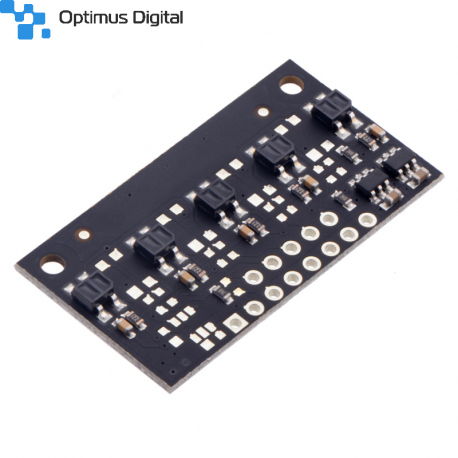 View larger
View larger
QTR-MD-05RC Reflectance Sensor Array: 5-Channel, 8mm Pitch, RC Output
0104110000068507
New product
This array of IR LED/phototransistor pairs is great for precisely identifying changes in reflectance (like line detection). It operates from 2.9 V to 5.5 V and offers dimmable brightness control independent of the supply voltage. In general, the closer the object, the higher the contrast between light and dark readings, but high-reflectance objects are generally detectable out to around 40 mm. This version features the traditional-style QTR sensors without lenses.
| pitch x sensors | size (mm) | output | max current | optimal range | |
| LED | board | ||||
| 8 mm x 5 | 37.0 x 20.0 | RC (digital) | 30 mA | 93 mA | 5 mm |
See description for more details about the product.
Add to cart now!
2 Items
Warning: Last items in stock!
- Write a review
- Remove this product from my favorite's list.
- Add this product to my list of favorites.
More info
Description
Details

Pinout diagram of a QTR-MD-xRC Reflectance Sensor Array.
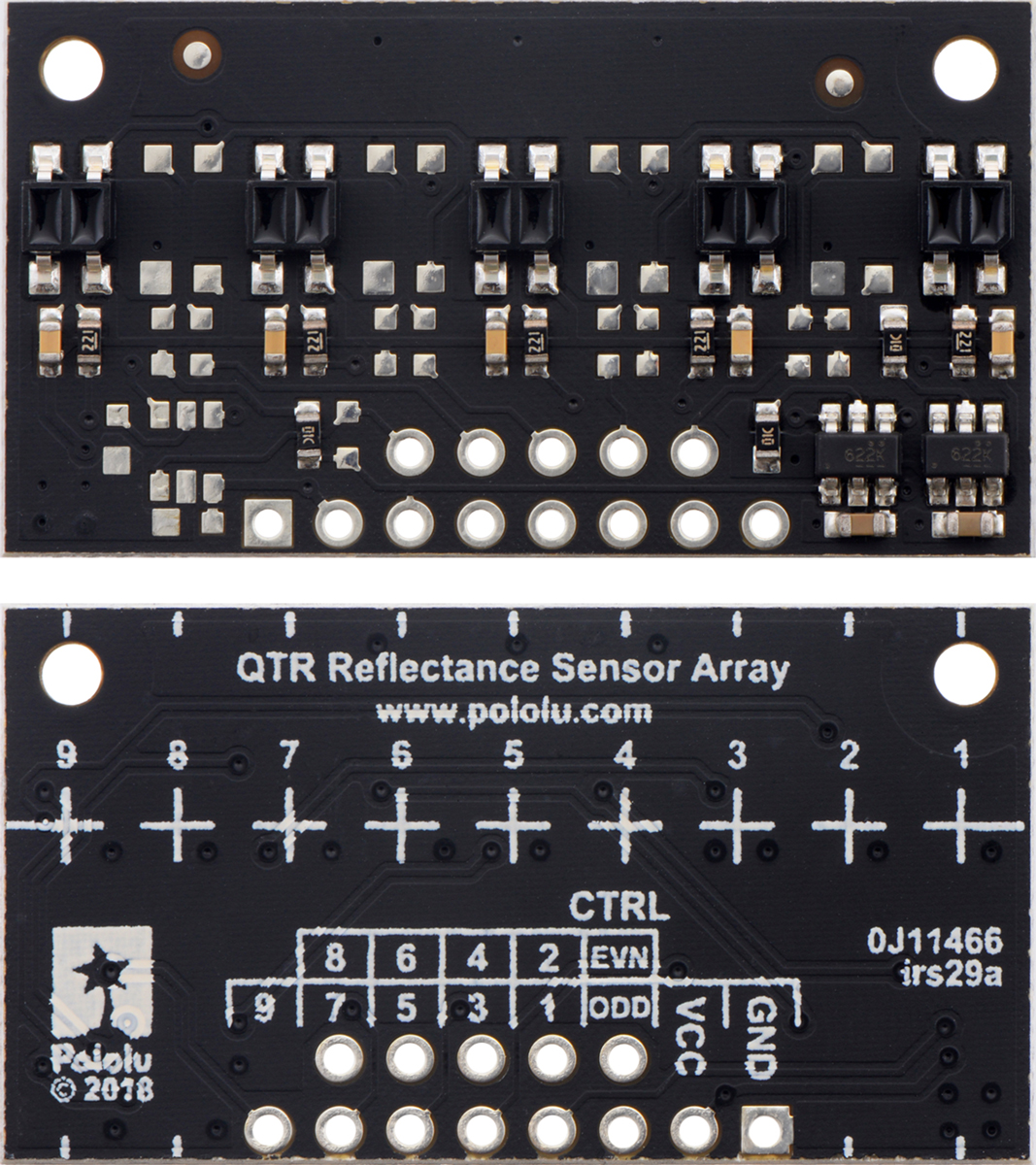
QTR-MD-05RC Reflectance Sensor Array, front and back views.
Specifications
• Dimensions: 37.0 x 20.0 x 2.5 mm (see the dimension diagram (1MB pdf) for more details)
• Operating voltage: 2.9 V to 5.5 V
• Sensor type: QTR
• Sensor count: 5
• Sensor pitch: 8 mm
• Full-brightness LED current: 30 mA (independent of supply voltage)
• Max board current: 93 mA
• Output format: digital I/O-compatible signals that can be read in parallel as timed high pulses
• Optimal sensing distance: 5 mm
• Maximum recommended sensing distance: 40 mm
• Weight: 1.9 g
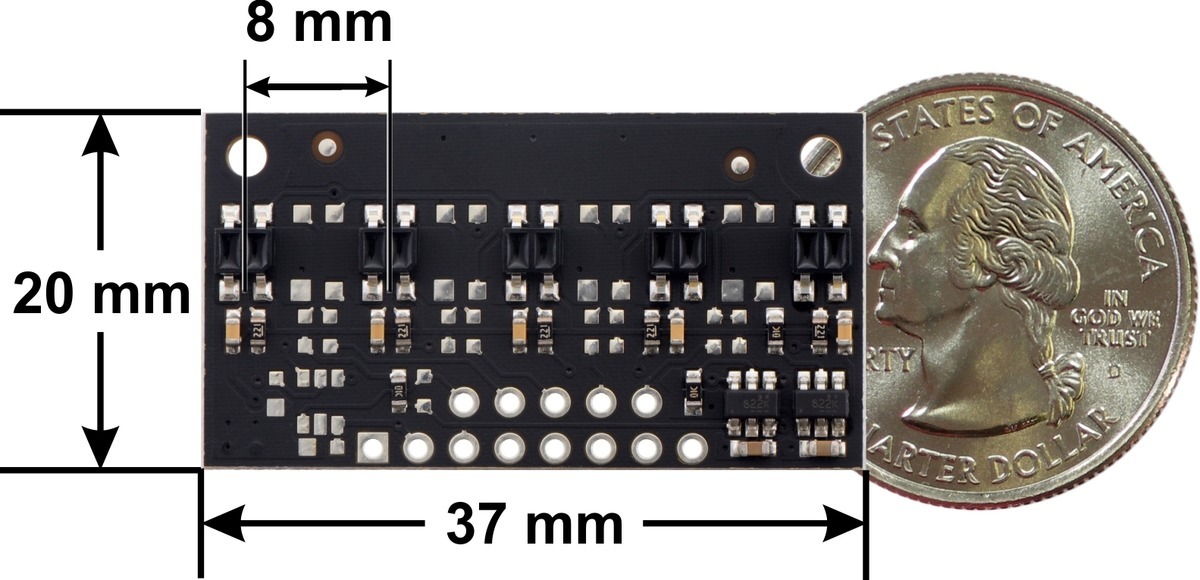
QTR-MD-05RC Reflectance Sensor Array dimensions.
QTR family overview
These reflectance sensors feature a linear array of infrared emitter/phototransistor pair modules in a high-density (4 mm pitch) or medium-density (8 mm pitch) arrangement, which makes them well suited for applications that require detection of changes in reflectivity. This change in reflectivity can be due to a color change at a fixed distance, such as when sensing a black line on a white background, as well as due to a change in the distance to or presence of an object in front of the sensor. A variety of sensor counts and densities is available so you can pick the ideal arrangement for your application. Since the outputs are all independent, you can connect just some of the channels to attain an irregular or non-standard sensor spacing.

Unlike our original QTR sensor modules, these units have integrated LED drivers that provide brightness control independent of the supply voltage, which can be anywhere from 2.9 V to 5.5 V, while enabling optional dimming to any of 32 possible brightness settings. For high-density (HD) modules with five or more sensors and medium-density (MD) modules with eleven or more sensors, there are separate controls for the odd-numbered and even-numbered LEDs, which gives you extra options for detecting light reflected at various angles. See the “Emitter control” section below for more information on using this feature.
Two different sensor options are available, denoted by "QTR" or "QTRX" in the product name. The "QTR" versions feature lower-cost sensor modules without lenses while the “QTRX” versions feature higher-performance sensor modules with lenses, which allow similar performance at a much lower IR LED current. You can see the two different sensor styles in the pictures below of the 4-channel modules:
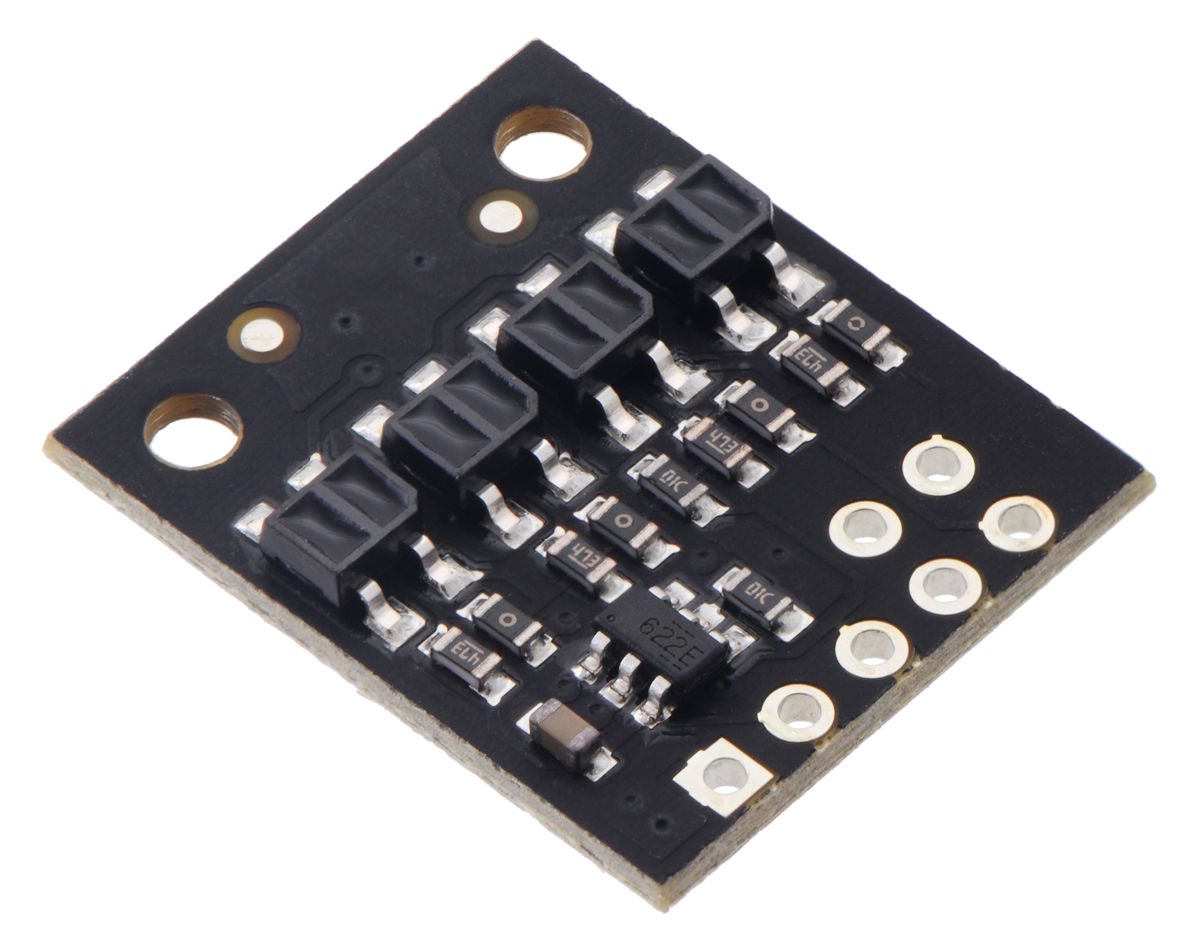
QTR-HD-04A Reflectance Sensor Array.
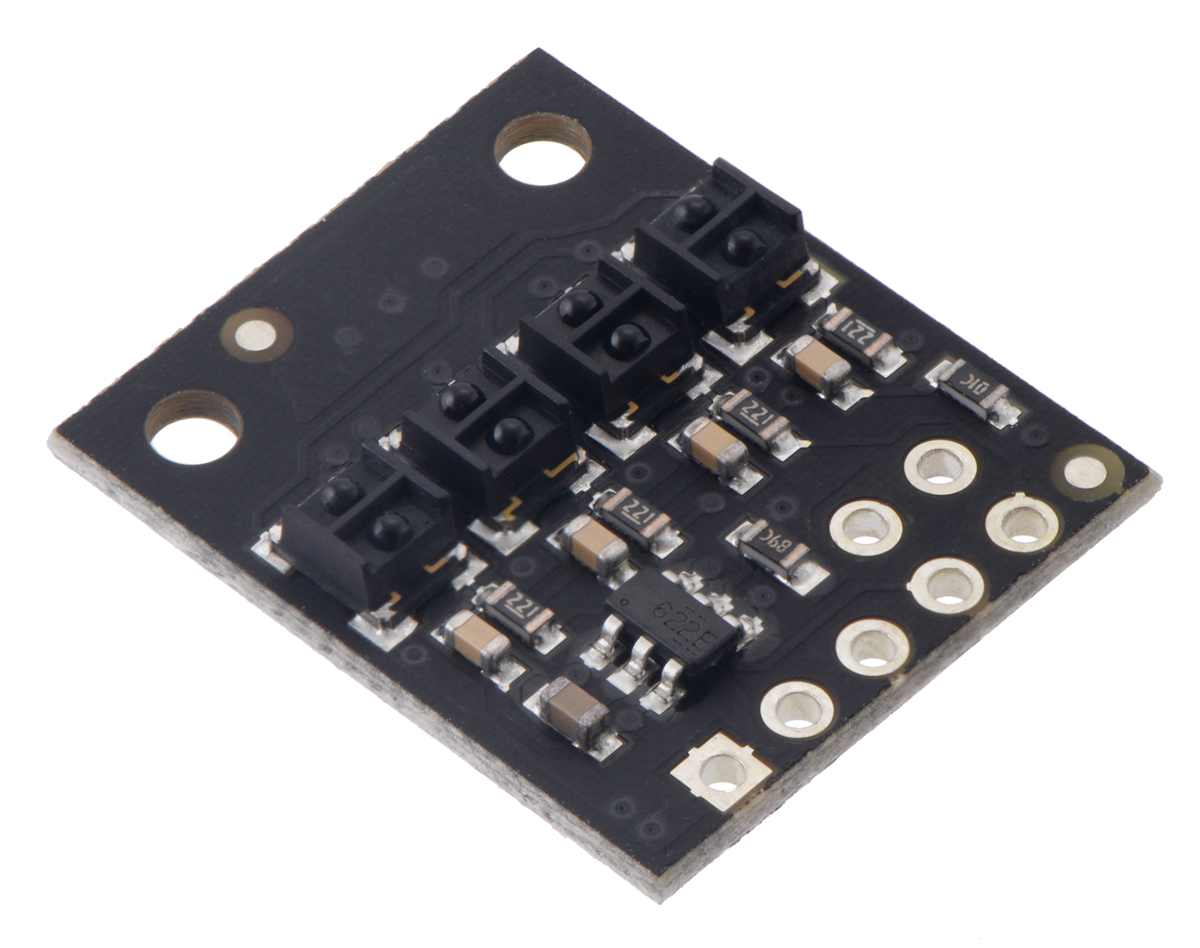
QTRX-HD-04RC Reflectance Sensor Array.
We also have several single-channel modules with the "QTRXL" designator that offer extra-long range by using the QTRX-style sensor module with higher current through the emitter.
Each sensor option is available in two output types: an "A" version with analog voltage outputs between 0 V and VCC, and an “RC” version with outputs that can be read with a digital I/O line on a microcontroller by first setting the lines high and then releasing them and timing how long it takes them to read as low (typically anywhere from a few microseconds to a few milliseconds). The lower the output voltage or shorter the voltage decay time, the higher the reflectance. The following simplified schematic diagrams show the circuits for the individual channels:
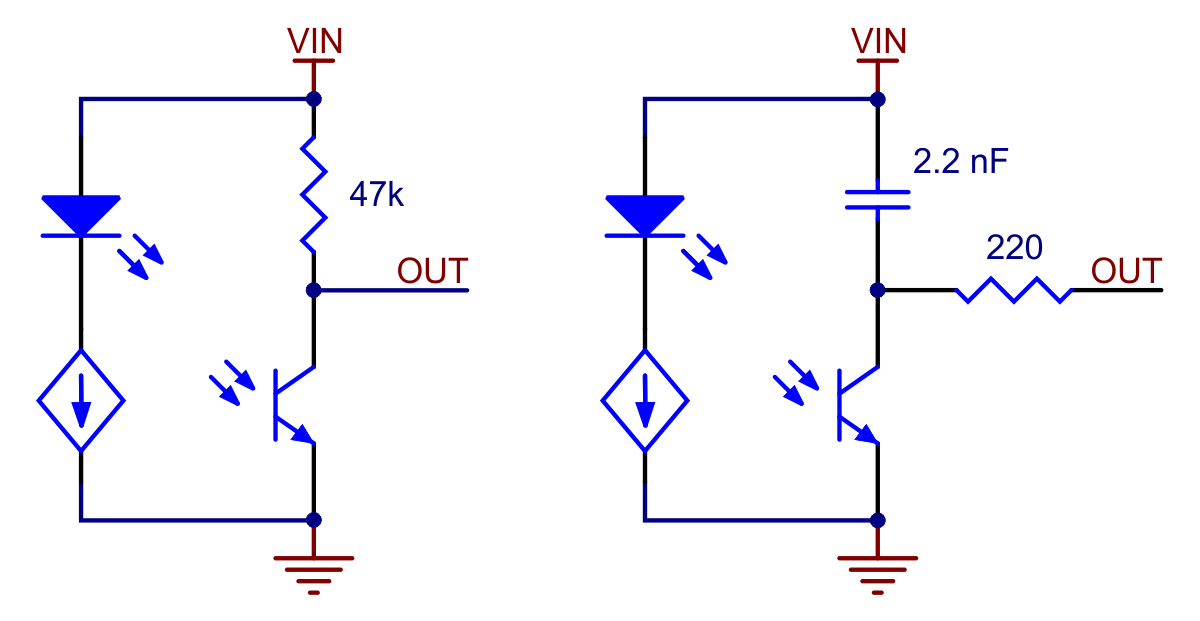
Schematic diagrams of individual QTR sensor channels for A version (left) and RC version (right). This applies only to the newer QTRs with dimmable emitters.
Interfacing with the outputs of the A versions
Each sensor on the A versions outputs its reflectance measurement as an analog voltage that can range from 0 V when the reflectance is very strong to VCC when the reflectance is very weak. There are several ways you can interface with the analog output:
• Use a microcontroller’s analog-to-digital converter (ADC) to measure the voltages.
• Use a comparator with an adjustable threshold to convert each analog voltage into a digital (i.e. black/white) signal that can be read by the digital I/O line of a microcontroller.
• Connect each output directly to a digital I/O line of a microcontroller and rely upon its logic threshold.
This last method will work if you are able to get high reflectance from your white surface as depicted in the left image, but will probably fail if you have a lower-reflectance signal profile like the one on the right.
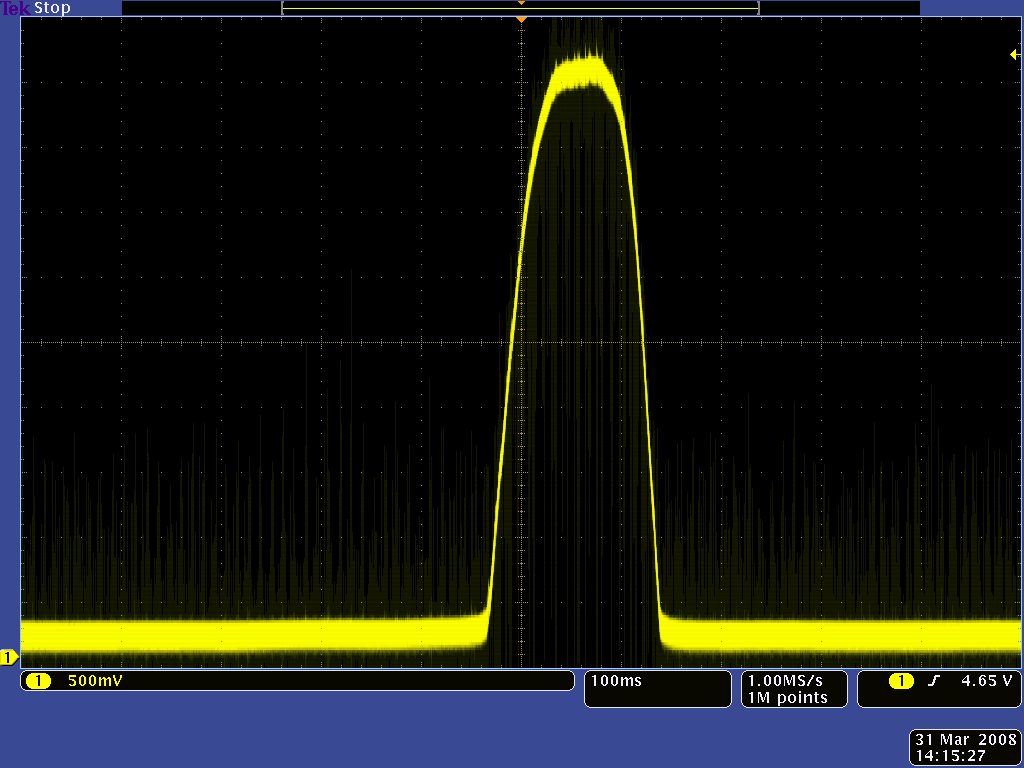
QTR-1A output 1/8" away from a spinning white disk with a black line on it.
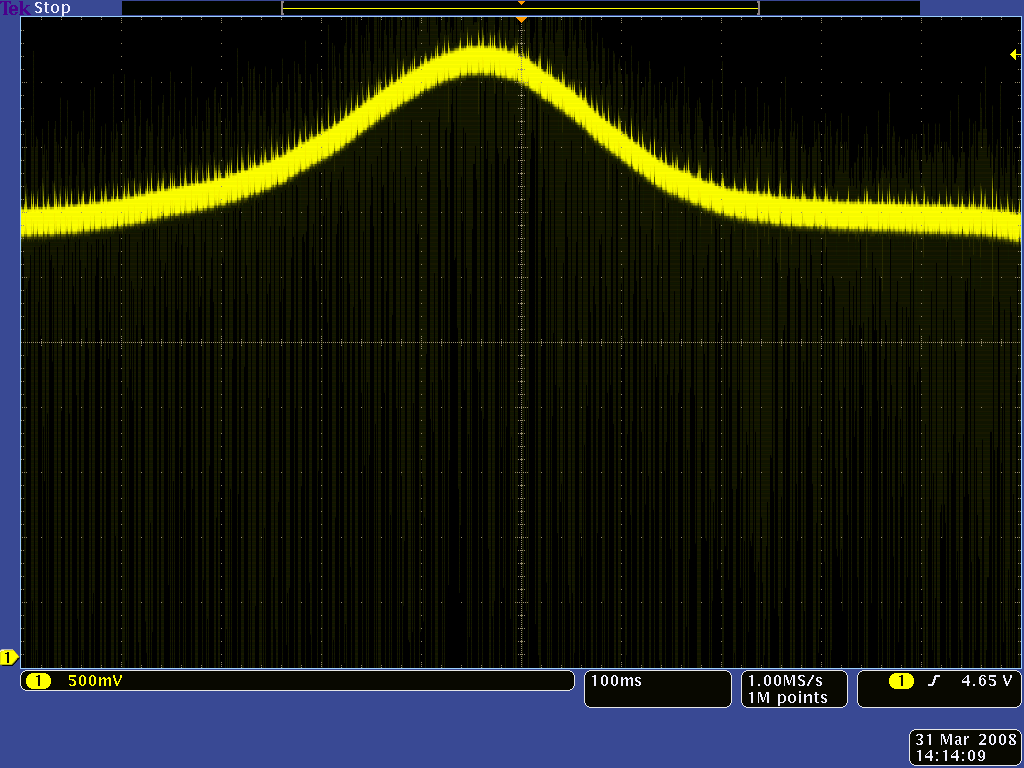
QTR-1A output 3/8" away from a spinning white disk with a black line on it.
Interfacing with the outputs of the RC versions
Each sensor on the RC versions requires a digital I/O line capable of driving the output line high and then measuring the time for the output voltage to decay. The typical sequence for reading a sensor is:
1. Turn on IR LEDs (optional).
2. Set the I/O line to an output and drive it high.
3. Allow at least 10 μs for the sensor output to rise.
4. Make the I/O line an input (high impedance).
5. Measure the time for the voltage to decay by waiting for the I/O line to go low.
6. Turn off IR LEDs (optional).
These steps can typically be executed in parallel on multiple I/O lines.
QTR-1RC output (yellow) when 1/8" above a black line and microcontroller timing of that output (blue).

QTR-1RC output (yellow) when 1/8" above a white surface and microcontroller timing of that output (blue).
With a strong reflectance, the decay time can be as low as a few microseconds; with no reflectance, the decay time can be up to a few milliseconds. The exact time of the decay depends on your microcontroller’s I/O line characteristics. Meaningful results can be available within 1 ms in typical cases (i.e. when not trying to measure subtle differences in low-reflectance scenarios), allowing up to 1 kHz sampling of all sensors. If lower-frequency sampling is sufficient, you can achieve substantial power savings by turning off the LEDs. For example, if a 100 Hz sampling rate is acceptable, the LEDs can be off 90% of the time, lowering average current consumption from 125 mA to 13 mA.
Emitter control
These reflectance sensor arrays maintain a constant current through their IR emitters, keeping the emitters’ brightness constant, independent of the supply voltage (2.9 V to 5.5 V). The emitters can be controlled with the board’s CTRL pins, and the details of the control depends on the array size and density:
• HD units with 5 or more sensors and MD units with 11 or more sensors have two emitter control pins: CTRL ODD and CTRL EVEN. By default, these are connected together with a 1 kΩ resistor and pulled up, turning on all the emitters by default and allowing them to be controlled with a signal on either pin, but the CTRL ODD and CTRL EVEN pins can be driven separately for independent control of the odd-numbered and even-numbered emitters.
• MD units with 3-10 sensors also have two emitter control pins since these are made by only populating every other sensor on an HD board, but only the CTRL ODD pin will have an effect on these versions (it is not possible to independently control alternate emitters).
• HD units with 4 or fewer sensors and MD units with 2 or fewer sensors have a single CTRL pin that controls all of the emitters.
Driving a CTRL pin low for at least 1 ms turns off the associated emitter LEDs, while driving it high (or allowing the board to pull it high) turns on the emitters with the board’s default (full) current, which is 30 mA for “QTR” versions and 3.5 mA for "QTRX" versions. For more advanced use, the CTRL pin can be pulsed low to cycle the associated emitters through 32 dimming levels.
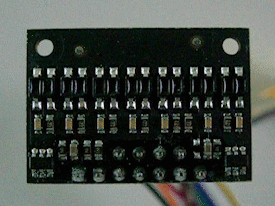
Demo of IR LED dimming and independent even/odd control on the QTR-HD-07x (as seen through an old digital camera that can see IR).
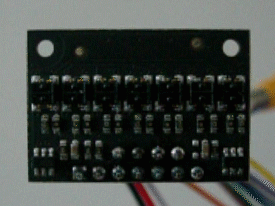
Demo of IR LED dimming and independent even/odd control on the QTRX-HD-07x (as seen through an old digital camera that can see IR).
To send a pulse, drive the CTRL pin low for at least 0.5 μs (but no more than 300 μs), then high for at least 0.5 μs; (it should remain high after the last pulse). Each pulse causes the driver to advance to the next dimming level, wrapping around to 100% after the lowest-current level. Each dimming level corresponds to a 3.33% reduction in current, except for the last three levels, which represent a 1.67% reduction, as shown in the table below. Note that turning the LEDs off with a >1 ms pulse and then back on resets them to full current.

For example, to reduce the emitter current to 50%, apply 15 low pulses to the CTRL pin and then keep it high after the last pulse.
Specifications
Dimensions
| Size: | 37.0 x 20.0 x 2.5 mm |
| Weight: | 1.9 g |
General specifications
| Maximum range: | 40 mm |
| Optimal range: | 5 mm |
| Minimum operating voltage: | 2.9 V |
| Maximum operating voltage: | 5.5 V |
| LED current: | 30 mA1 |
| Peak wavelength: | 940 nm |
| Maximum current draw: | 93 mA2 |
| Sensor type: | QTR |
| Sensor pitch: | 8.0 mm |
| Sensor count: | 5 |
| Output type: | RC (measurable by digital I/O) |
Notes:
1 Can be dynamically reduced to any of 32 available dimming levels.
2 With all LEDs on at max brightness setting.
3 Note: this does not differentiate between the A and RC output types.
Don't delay, buy today.
Add to cart now!
Reviews
Customers who bought this product also bought:
-
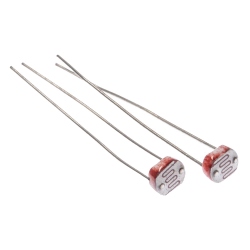
Photoresisto...
This product is light-sensitive and very useful...
$0.36
-
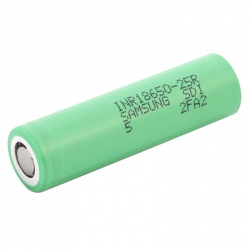
2500 mAh...
2500 mAh 18650 INR18650-25R 20 A Samsung Li-Ion...
$6.00
-
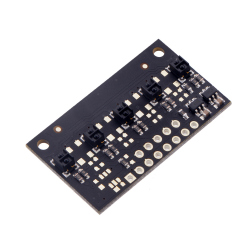
QTRX-MD-05A...
This array of IR LED/phototransistor pairs is...
$7.20






